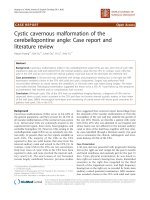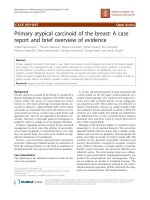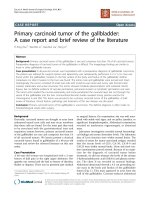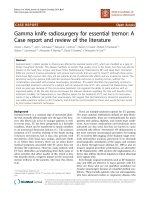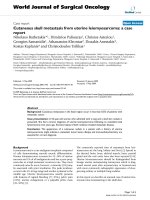báo cáo khoa học: "Prostate cancer metastases to the rectum: A case report" ppsx
Bạn đang xem bản rút gọn của tài liệu. Xem và tải ngay bản đầy đủ của tài liệu tại đây (866.08 KB, 3 trang )
CAS E REP O R T Open Access
Prostate cancer metastases to the rectum:
A case report
Tariq O Abbas, Abdulla R Al-Naimi
*
, Rafie A Yakoob, Issam A Al-Bozom and Abdulkader M Alobaidly
Abstract
Prostate cancer rarely metastasis to the rectum. Findings in the patient reported here emphasize the importance of
the relationship between urinary and gastrointestinal symptoms in detecting prostatic neoplasms in older male
patients.
Background
Prostate cancer has the potential to advance loco-
regionally to adjacent organs. This spread can take place
via different routes, including direct invasion and
through lymphatic channels. It is very rare for prostate
cancer to metastasize to nearby organs, including the
rectum. We describe here a patient presenting with
prostate cancer metastasizing to the rectum.
Case report
A 60-year-old man was referred to our urology facility
after experiencing severe weight loss (30 kg in 3
months) and bleeding from the rectum, together with
upper a bdominal pain and vomiting. Over the previous
year, he had experienced painless hematuria and voiding
difficulty.
He was thoroughly examined, including undergoing a
colonoscopy, which reveale d a distal rectal sessile mass
lying about 15 cm from the anal verge [Figure 1]. Histo-
pathologic examination of the biopsy showed that it was
a metastatic prostatic adenocarcinoma [Figure 2].
A CT scan of his abdomen showed that the prostatic
mass had invaded the urinary bladder wall and that the
biopsied mass was separate from the rectum [Figure 3].
His serum PSA concentration was high (983 ng/ml). In
addition, TC-99 MDP bone scintigraphy showed wide-
spread bone metastatic lesions [Figure 4].
He was started on hormone therapy and followed up
by the oncology department.
Discussion
Prostate cancer is a slowly growing neoplasm that can
easily be missed during its early stages. Patients not pre-
viously diagnosed with prostatic adenocarcinoma may
present initially with metastases [1]. In contrast, PSA
may not be expressed i n all patients with prostatic ade-
nocarcinoma [2].
Prostate cancer extension to colorectal tissue can
occur through at least 3 potential routes. The first is
direct invasion through Denonvilliers fascia and infiltra-
tion into the rectum. The second is through lymphatics,
since the prostate and rectum share some lymphatic
drainage to groups of pelvic lymph node [3] . Third,
prostate cancer cells can spread through needle biopsy,
by seeding into peri-rectal or rectal tissue along the nee-
dle biopsy; this, route, however, is extremely rare [4,5].
Prostate cancer metast asis to the recto-sigmoid region
can occur by subserosal metastatic implant of the malig-
nant tissues [6]. The incidence of rectal infiltration by
prostatic adenocarcinoma is e xtremely rare, being
encountered on average once every two years by a busy
colorectal practice [7].
Conclusion
Findings in the patient reported here emphasize the
importance of the relationship between urinary an d gas-
trointestinal symptoms in detecting prostatic neoplasms
in older male patients. Careful immunohistochemical
examination of specimens can prevent major surgical
interventions in favor of hormonal and radiological
therapies.
* Correspondence:
Hamad General Hospital, Doha, Qatar
Abbas et al. World Journal of Surgical Oncology 2011, 9:56
/>WORLD JOURNAL OF
SURGICAL ONCOLOGY
© 2011 Abbas et al; licensee BioMed Central Ltd. This is an Ope n Access articl e distributed under the terms of the Crea tive Commons
Attribu tion License ( which permits unrestricted use, distribution, and repro duction in
any medium, provided the original work is properly cited.
Consent
Written informed consent was obtained from the patient
for publication of this case report and accompanying
images. A copy of the written consent is available for
review by the Editor-in-Chief of this journal.
Authors’ contributions
TA carried out the history, physical examination and the provisional draft.
AAN participitate in the sequence alignment and drafted the manuscript
again. IAB carried out the histopathology.
Figure 1 Colon oscopy picture showing a distal rectal sessile
mass lying about 15 cm from the anal verge.
Figure 2 (Top) Sections showing tumor acini adjacent to a
normal colonic crypt (Hematoxylin & Eosin ×400); (Bottom)
Staining of the same microscopic focus with anti-PSA antibody,
showing that tumor cells were positive while normal colonic
crypts were negative (immunohistochemistry-PSA ×400).
Figure 3 CT scan of the abdomen showing the prostatic mass
invading the urinary bladder wall and being separate from the
rectum.
Figure 4 TC-99 MDP bone scint igraphy showing widespread
bone metastatic lesions.
Abbas et al. World Journal of Surgical Oncology 2011, 9:56
/>Page 2 of 3
RY carried out the colonoscopy and the re ctal biopsy.
AA involoved in the patient management and data collection.
All authors read and approved the final manuscript.
Competing interests
The authors declare that they have no competing interests.
Received: 19 June 2010 Accepted: 21 May 2011 Published: 21 May 2011
References
1. Hematpour K, Bennett CJ, Rogers D, Head CS: Supraclavicular lymph node:
incidence of unsuspected metastatic prostate cancer. Eur Arch
Otorhinolaryngol 2006, 263(9):872-874.
2. Gallee MP, Visser-de Jong E, van der Korput JA, van der Kwast TH, ten
Kate FJ, Schroeder FH, Trapman J: Variation of prostate-specific antigen
expression in different tumour growth patterns present in
prostatectomy specimens. Urol Res 1990, 18(3):181-187.
3. Murray SK, Breau RH, Guha AK, Gupta R: Spread of prostate carcinoma to
the perirectal lymph node basin: analysis of 112 rectal resections over a
10-year span for primary rectal adenocarcinoma. Am J Surg Pathol 2004,
28(9):1154-1162.
4. Vaghefi H, Magi-Galluzzi C, Klein EA: Local recurrence of prostate cancer
in rectal submucosa after transrectal needle biopsy and radical
prostatectomy. Urology 2005, 66:881.
5. Lane Z, Epstein JI, Ayub S, Netto GJ: Prostatic adenocarcinoma in
colorectal biopsy: clinical and pathologic features. Hum Pathol 2008,
39(4):543-549.
6. Gengler L, Baer J, Finby N: Rectal and sigmoid involvement secondary to
carcinoma of the prostate. Am J Roentgenol Radium Ther Nucl Med 1975,
125(4):910-917.
7. Bowrey DJ, Otter MI, Billings PJ: Rectal infiltration by prostatic
adenocarcinoma: report on six patients and review of the literature. Ann
R Coll Surg Engl 2003, 85:382-385.
doi:10.1186/1477-7819-9-56
Cite this article as: Abbas et al.: Prostate cancer metastases to the
rectum: A case report. World Journal of Surgical Oncology 2011 9:56.
Submit your next manuscript to BioMed Central
and take full advantage of:
• Convenient online submission
• Thorough peer review
• No space constraints or color figure charges
• Immediate publication on acceptance
• Inclusion in PubMed, CAS, Scopus and Google Scholar
• Research which is freely available for redistribution
Submit your manuscript at
www.biomedcentral.com/submit
Abbas et al. World Journal of Surgical Oncology 2011, 9:56
/>Page 3 of 3
